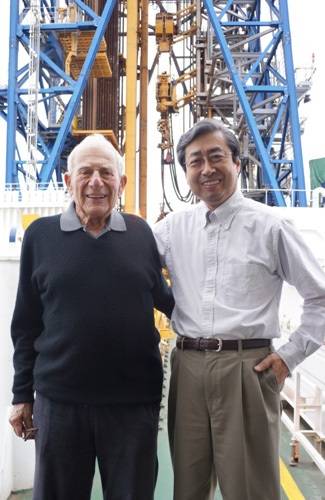Gateway Technology for Ocean Measurements
Scientists at Scripps Institution of Oceanography at UC San Diego, in collaboration with two private industry firms, are developing potentially breakthrough technologies to capture vital information from the world’s oceans.
Scripps researchers John Orcutt and Jon Berger developed a Memorandum of Understanding with Horton Wison Deepwater (HWD) and John Crane Production Solutions (JCPS) in developing new, uniquely stable and long-lasting ocean buoys with sensors moored to the seafloor to measure ground motion, water column pressure, pH, current speed and direction, optical and acoustic backscatter, salinity, temperature, and myriad other variables over extended periods of time.
Placing sensors on traditional platforms and ships capable of making these measurements is expensive and the sensors themselves tend to lack the necessary stability needed for long term monitoring. The newly designed “taut-moored array” will be moored to the seafloor, outfitted with a renewable energy power supply and fiber optics, with data relayed through a surface antenna.
The Tendon Anchored Composite Ocean Spar, or “TACOS,” designed by HWD and Scripps, has the potential to support a number of deep-water instruments with minimal installation costs.
“We believe TACOS will both reduce life cycle costs enormously while also enhancing sensor stability and data availability,” Orcutt said. “We are combining the proposed new technologies with our past experience in ocean observations and information technology. This will become a gateway technology for these measurements as well as the technologies needed to connect more accurate sensors to the laboratory, classroom and citizens, including those responsible for informed decision making.”
A key to the TACOS design is the replacement of the currently used multi-legged mooring between the surface and the seafloor with a single, economical tether, which restricts buoy motions. JCPS specializes in the “pultrusion” of very strong, composite tendons, which involves running a number of glass or carbon fibers through a die, where an adhering resin is infused to secure the fibers in a particular orientation. The rod is pulled at such a rate that the adhering resin can set during the procedure. The resulting members have enormous strength in tension and are very resistant to corrosion and biofouling.
Berger and Orcutt said the new design will accelerate efforts to gather information about the oceans and the planet.
“The oceans comprise more than 70% of Earth’s surface and serve as a sink for most of the anthropogenic carbon and resultant heat created by greenhouse warming,” Berger said. “Also, the most destructive earthquakes and tsunamis in the past decade were created within the seafloor. While the chemistry and physics of these phenomena are generally well-known, long-term measurements of the underlying changes are wanting.”
HWD has designed, developed and tested large numbers of offshore rigs based on a spar design with flotation away from the surface to avoid large vertical motions. JCPS has expertise in the design, development, testing and construction of inexpensive composite materials suitable for applications in the marine environment.
TACOS will operate as a uniquely stable system that demands much less maintenance than other buoy designs. With the composite spar buoy at the top the system will operate similar to the U.S. Navy/Office of Naval Research’s Floating Instrument Platform (FLIP), which is operated by Scripps.
The researchers estimate the total project cost will be $3.7 million, which includes project funding development, system design and fabrication, installation and operation in Southern California waters for one year.
Berger and his colleagues have successfully applied fiber optics, lasers, and interferometry to create a number of very sensitive, stable sensors for measuring seismic motion, strain, pressure, and acoustics. The scientists hope to extend this work with TACOS, as well as the National Science Foundation-funded HiSeasNet facilities, to the oceans and expand the sensor sets needed for measuring not only seismic and geodetic motion in situ, but climate variables including heat content, deep ocean temperature measurements and ocean thickness variability due to sea-level rise.
One of the team’s design criteria for the project is that the buoy operate for 20 years without replacement to substantially reduce the replacement costs characteristic of other buoys with lifetimes of 2-3 years at most. Another design criterion for these systems is the ability to be deployed from a global class University-National Oceanographic Laboratory System (UNOLS) ship such as Scripps research vessels Roger Revelle and Melville (owned by the U.S. Navy).
The researchers have outlined a two-phase program plan to conduct a scientific requirements design study of the TACOS platform and construct, install and operate an initial prototype. Scripps, HWD, and JCPS will secure funding for the construction, deployment and operations funds as soon as the design phase nears an end.
scripps.ucsd.edu

















